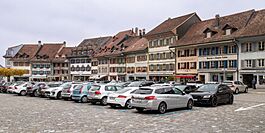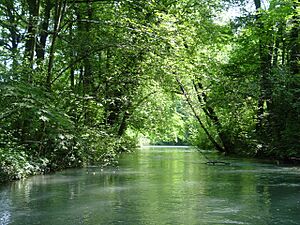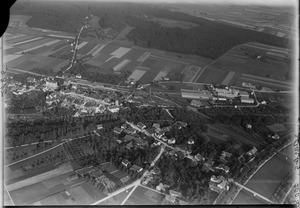Aarberg facts for kids
Quick facts for kids
Aarberg
|
||
|---|---|---|

Stadtplatz (Town square)
|
||
|
||
| Country | Switzerland | |
| Canton | Bern | |
| District | Seeland | |
| Area | ||
| • Total | 7.93 km2 (3.06 sq mi) | |
| Elevation
(Stadtplatz)
|
455 m (1,493 ft) | |
| Population
(Dec 2020 )
|
||
| • Total | 4,626 | |
| • Density | 583.4/km2 (1,510.9/sq mi) | |
| Postal code |
3270
|
|
| Surrounded by | Bargen, Kappelen, Lyss, Radelfingen, Seedorf | |
Aarberg is a historic town and a municipality in the Seeland area of the canton of Bern in Switzerland. It's about 20 kilometers (12 miles) from Bern.
Aarberg is located on the Aare river. It shares borders with towns like Bargen, Kappelen, Lyss, Radelfingen, and Seedorf.
The town was once on an island, surrounded by the Aare and a smaller river called the Little Aare. The old town grew around the island's edge, with a big open square in the middle. Besides the old town, Aarberg also has newer parts and small villages like Spins, Mühletal, and Grafenmoos.
The main language spoken in Aarberg is a local form of Swiss German. The official language is German.
Contents
- Aarberg's Past: A Look at its History
- Aarberg's Natural Surroundings: Geography
- Aarberg's Symbol: Coat of Arms
- Who Lives in Aarberg: Demographics
- Important Buildings: Heritage Sites
- How Aarberg Works: Economy
- Beliefs in Aarberg: Religion
- Learning in Aarberg: Education
- Getting Around: Transportation
- Famous People from Aarberg
- See also
Aarberg's Past: A Look at its History
|
County of Aarberg
Grafschaft Aarberg
|
|||||||||
|---|---|---|---|---|---|---|---|---|---|
| ca 1220–1379 | |||||||||
| Status | County | ||||||||
| Capital | Aarberg | ||||||||
| Common languages | Alemannic | ||||||||
| Government | County | ||||||||
| Historical era | Middle Ages | ||||||||
|
• town settled
|
before 1138 | ||||||||
|
• town and county founded
|
ca 1220 1220 | ||||||||
|
• Gained town rights
|
1271 | ||||||||
|
• Peter II attempts
to pawn county |
from 1358 |
||||||||
|
• Sold to Bern
|
1379 | ||||||||
|
|||||||||
Aarberg was once an island surrounded by the Aare and Little Aare rivers. By 1138, there was a small hospital and a bridge called Bargenbrügg over the Aare. This bridge was very important for crossing the river between Bern and Büren an der Aare.
How Aarberg Was Founded
The town was founded between 1220 and 1225 by Count Ulrich III of Neuchâtel. He needed a central place to rule the region he had recently gained. The island and its important bridge were perfect for a new town. Aarberg was first mentioned in records in 1236 as Arberc. By the 14th century, it was on a major trade route. Old Roman roads connecting cities like Solothurn, Aarberg, and Murten passed nearby.
The town's oldest official seal is from 1249. In 1271, Ulrich IV confirmed the town's special rights. At first, Aarberg had no walls, just wooden houses around a narrow central square. After fires in 1419 and 1477, the town was rebuilt with stone houses. They were set back about 10 meters (33 feet), creating the unique, lens-shaped main square you see today.
Aarberg Under Bernese Rule
Aarberg was attacked in 1339, 1382, and 1386 but was never captured. In 1358, Count Peter von Aarberg had money problems and tried to sell the town. After many tries, he finally sold Aarberg and his ruling rights to Bern between 1377 and 1379.
A Bernese official called a bailiff moved into Aarberg Castle in 1379. In 1414, Bern took over the responsibility for the bridges over the Aare. These bridges were expensive to build and repair. They were rebuilt many times after floods, and the current bridge dates from 1567–68.
The church in Aarberg was built in 1484. It was rebuilt in 1575 on the site of the old Aarberg castle. The church tower, built in 1526, used stones from a demolished Pilgrim Hospital Church. After the Protestant Reformation in 1528, the church's connection to the Münster of Bern ended.
The town was governed by a mayor and a 24-member council. A vogt (a type of governor) lived in the Amthaus (built 1608-10) and had important legal powers.
Trade and Changes in Aarberg
Aarberg has always been important for trade because of its location on the Aare river and near major trade roads. The large central market square was one of Switzerland's biggest trading hubs. Many transport companies and inns, like the Tavernen Krone (Crown) and Tavernen Falken (Falcon), grew around the square.
The yearly market, first mentioned in 1271, became very important. By 1478, it attracted merchants selling salt, iron, steel, and cloth from all over the region. The town also tried to get into farming by buying land in other areas.
The French invasion of Switzerland in 1798 caused damage to the town. Aarberg was part of the Zollikofen District under the Helvetic Republic until 1803. After that, it became the capital of the Aarberg county. In 1830, during the Paris July Revolution, the Swiss Army commanders moved to Aarberg. The fortified town was a key defense point on the western border.
Everything changed for Aarberg with the invention of the railroad and changes to the Jura rivers. The Bern-Lyss-Biel railway line completely bypassed Aarberg, which meant less trade came through the town. Even new railway lines and paved roads didn't bring back the old trade levels.
At the same time, the Hagneck canal redirected part of the Aare river. This stopped the town from flooding regularly. The Kleine Aare was dammed, and Aarberg island became a peninsula.
During the 19th century, business in Aarberg slowed down, but the town still grew. New areas were built where the Aare river used to flow. Business shifted from transportation to farming, concrete construction, and making precision parts.
Aarberg's Natural Surroundings: Geography
Aarberg covers an area of about 7.93 square kilometers (3.06 square miles).
- About 44.4% of this land is used for farming.
- About 29.6% is covered by forests.
- About 23.5% has buildings or roads.
- About 2.3% is rivers or lakes.
Aarberg was historically important because it was the only place to cross the Aare river between Bern and Büren an der Aare. This made it a key market town and a stop for trade along the river and around Bern.
Aarberg's Symbol: Coat of Arms
The blazon (description) of Aarberg's coat of arms is: a black eagle with a gold beak and claws, and a red tongue, rising from three red hills on a silver background.
Who Lives in Aarberg: Demographics
Aarberg has a population of about 4,600 people (as of 2022). About 10.8% of the people living here are foreign nationals. Over the last 10 years, the population has grown by about 7.9%.
Most people in Aarberg (about 90.5%) speak German as their first language. Italian and Turkish are the next most common languages.
In 2000, about 23.6% of the population were children and teenagers (0–19 years old). Adults (20–64 years old) made up 62%, and seniors (over 64 years old) made up 14.4%.
The number of people living in Aarberg has changed over time, as shown in this chart:

Important Buildings: Heritage Sites
The covered wooden bridge and the Liechti house are very important historical sites in Switzerland. The entire old town of Aarberg is also recognized as a significant heritage site.
The Old Town Square
The large, round square in Aarberg's old town is used for many events. These include markets, light shows, and outdoor theater. One of the most famous events is the Puce, which is a flea market. It's known as one of the biggest and most fun flea markets in Switzerland. Started in 1977, the Puce now has about 250 sellers. It happens on the last weekend of April and August.
Aarberg Castle
Schloss Aarberg (Aarberg Castle) was first built in 1220. From 1358 until 1830, about 100 Vögte (governors) lived in the castle. Today, it serves as the town hall, the county seat, and the local police station. The Hotel Krone is next to the castle.
The Church
The late Gothic church was built in 1526 but quickly burned down. It was rebuilt in 1576 and is used by the Swiss Reformed Church. The bell tower is one of the tallest buildings in Aarberg. The church has a single main hall and a choir. Both the pulpit (where sermons are given) and the organ are beautiful to see.
How Aarberg Works: Economy
In 2010, Aarberg had a low unemployment rate of 1.9%. In 2008, many people worked in different areas:
- 73 people worked in agriculture (farming).
- 847 people worked in the secondary sector, mostly in manufacturing (making things).
- 1,509 people worked in the tertiary sector, which includes services.
Many jobs in the service sector were in sales, transportation, hotels, restaurants, and healthcare. Aarberg is a place where more people come to work than leave. About 13.2% of workers use public transport, and 51% use a private car to get to work.
Beliefs in Aarberg: Religion
Based on the 2000 census:
- About 13% of people were Roman Catholic.
- About 69.8% belonged to the Swiss Reformed Church (Protestant).
- Smaller groups included Orthodox Christians, other Christian churches, and Muslims.
- Some people were Buddhist, Hindu, or had other beliefs.
- About 4.79% of the population did not belong to any church.
Learning in Aarberg: Education
In Aarberg, about 42.7% of the population have finished upper secondary education (like high school). About 12.5% have gone on to higher education, such as university.
The Bern school system has one year of optional Kindergarten, followed by six years of Primary school. Then, students go to three years of lower Secondary school, where they are grouped by their abilities. After this, students can continue their education or start an apprenticeship (learning a trade).
During the 2009–10 school year, 685 students attended classes in Aarberg.
- There were 4 kindergarten classes with 73 students.
- There were 17 primary classes with 271 students.
- There were 18 lower secondary classes with 341 students.
Aarberg also has a public library called the Gemeindebibliothek Aarberg. In 2008, it had over 12,913 books and other media.
Getting Around: Transportation
Aarberg has a railway station, Aarberg, on the Palézieux–Lyss railway line. You can take trains from here to Kerzers and Lyss.
There are also several bus lines connecting Aarberg to nearby towns:
- Bus Nr. 86 to Biel/Bienne
- Bus Nr. 100 to Berne
- Bus Nr. 365 to Seedorf (where you can connect to Bus Nr. 105 to Berne/Lyss)
- Bus Nr. 361 to Lyss.
Famous People from Aarberg
- Theodor Gohl (1844–1910): A Swiss architect.
- Kurt Wüthrich (born 1938): A Swiss chemist and biophysicist who won the Nobel Chemistry Prize. He's known for developing special methods using nuclear magnetic resonance (NMR).
- Andreas Fuhrer (born 1959): A retired Swiss sidecarcross rider who was a four-time World Champion. He lives in Aarberg.
- Thomas Bickel (born 1963): A retired Swiss football (soccer) midfielder.
- Martin Laciga (born 1975): A retired beach volleyball player.
|
See also
 In Spanish: Aarberg para niños
In Spanish: Aarberg para niños













